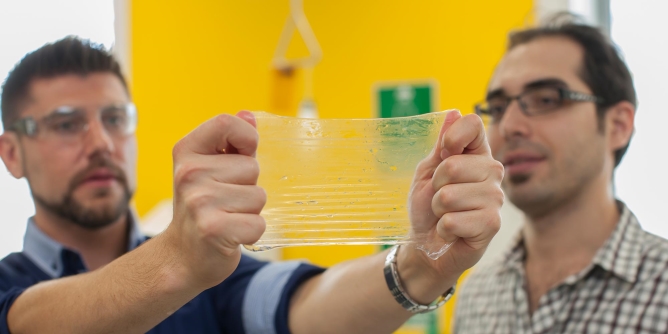Australian scientists lead the world in developing next generation condoms

Imagine a condom which not only feels like your own skin, it doesn't impede sensation and is embedded with "pleasure" attributes which activate the pleasure centres in your brain. Australian scientists are on the verge of a breakthrough in designing a condom for the 21st century that will be a pleasure to wear.
'It's really unusual to touch," said one of the developers, neuroscientist Joseph Ciorciari, "It feels like real human tissue, like when you're touching someone but they're covered in a lubricant."
The GELdom prototype condom is made from tough hydrogels created by a long chain polymer swollen with water. The material is wetter and softer than latex, similar to a squishy plastic, and extremely elastic. But it's their skin-like feel which gives them an edge over traditional latex or polyisoprene condoms. Hydrogels are not a new technology but using this technology to make condoms that people will want to wear because it actually improves sex is where Australia is leading the research.
Researchers at Swinburne University in Melbourne are using brain scanning technology to test the "pleasure" attributes of the prototype. Participants touch tested five different types of lubricated and non-lubricated latex as well as the ground breaking hydrogel material which looks like cling film. They were hooked up to an electroencephalogram machine (EEG) which identified any strong emotional responses triggered when the materials were touched. Brain scanning removed any potential bias by the study participants as "the brain doesn't lie" even if the test is about something as personal as the feel of a condom.
"The hydrogel was the only one that had a strong hot spot at the right front of the brain," Associate Professor Ciorciari said. "We also got a perceptual novelty response, as in 'oh that's different, I want to feel more of that'."
The first phase of research compared hydrogels to traditional latex condoms to see if the material met basic health requirements and blocked viruses such as STD's and HIV. They also underwent tensile testing, strength testing and the all important blow-up test. The most important test for users however is the tactile sensitivity, ie. how does it feel, which is where the Swinburne testing came into play. The researchers also hope to integrate benefits such as self-lubrication or pleasure enhancing pharmaceuticals into the material itself to create a condom that people can't wait to put on.
Increasing condom use worldwide, especially in countries where HIV cases are rising and where condom use is falling is important. Researchers hope the GELdom condoms can be developed to include antiviral and antibacterial chemicals inside and out. So the success of the project could have major implications for condom use around the globe.
The research has been made possible by way of a $100,000 grant to Project GELDOM from the Bill & Melinda Gates Foundation, which funds innovative ideas that address challenges in global health. So far the Foundation has awarded $100,000 to 11 groups around the globe with the mission to develop a "new generation of condoms that significantly preserve or enhance pleasure".



Likes & Comments
Comments (11)
Casualfun173
triXXXi66
FriendlyGuy1965
MasterRob643
AMM.Editor
lovelylady323
AMM.Editor
AlwaysFunBecRob
soilnriver
allinmymind
justforfun558